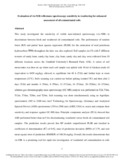JavaScript is disabled for your browser. Some features of this site may not work without it.
| dc.contributor.author | Douglas, Reward K. | |
| dc.contributor.author | Newar, S | |
| dc.contributor.author | Cipullo, Sabrina | |
| dc.contributor.author | Alamar, M. Carmen | |
| dc.contributor.author | Coulon, Frederic | |
| dc.contributor.author | Mouazen, A. M. | |
| dc.date.accessioned | 2018-02-19T19:09:35Z | |
| dc.date.available | 2018-02-19T19:09:35Z | |
| dc.date.issued | 2018-02-19 | |
| dc.identifier.citation | Douglas RK, Nawar S, Cipullo S, Alamar MC, Coulon F, Mouazen AM, Evaluation of vis-NIR reflectance spectroscopy sensitivity to weathering for enhanced assessment of oil contaminated soils, Science of the Total Environment, Volume 626, 1 June 2018, pp. 1108-1120 | en_UK |
| dc.identifier.issn | 0048-9697 | |
| dc.identifier.uri | http://dx.doi.org/10.1016/j.scitotenv.2018.01.122 | |
| dc.identifier.uri | http://dspace.lib.cranfield.ac.uk/handle/1826/13013 | |
| dc.description.abstract | This study investigated the sensitivity of visible near-infrared spectroscopy (vis-NIR) to discriminate between fresh and weathered oil contaminated soils. The performance of random forest (RF) and partial least squares regression (PLSR) for the estimation of total petroleum hydrocarbon (TPH) throughout the time was also explored. Soil samples (n = 13) with 5 different textures of sandy loam, sandy clay loam, clay loam, sandy clay and clay were collected from 10 different locations across the Cranfield University's Research Farm (UK). A series of soil mesocosms was then set up where each soil sample was spiked with 10 ml of Alaskan crude oil (equivalent to 8450 mg/kg), allowed to equilibrate for 48 h (T2 d) and further kept at room temperature (21 °C). Soils scanning was carried out before spiking (control TC) and then after 2 days (T2 d) and months 4 (T4 m), 8 (T8 m), 12 (T12 m), 16 (T16 m), 20 (T20 m), 24 (T24 m), whereas gas chromatography mass spectroscopy (GC–MS) analysis was performed on T2 d, T4 m, T12 m, T16 m, T20 m, and T24 m. Soil scanning was done simultaneously using an AgroSpec spectrometer (305 to 2200 nm) (tec5 Technology for Spectroscopy, Germany) and Analytical Spectral Device (ASD) spectrometer (350 to 2500 nm) (ASDI, USA) to assess and compare their sensitivity and response against GC–MS data. Principle component analysis (PCA) showed that ASD performed better than tec5 for discriminating weathered versus fresh oil contaminated soil samples. The prediction results proved that RF models outperformed PLSR and resulted in coefficient of determination (R2) of 0.92, ratio of prediction deviation (RPD) of 3.79, and root mean square error of prediction (RMSEP) of 108.56 mg/kg. Overall, the results demonstrate that vis–NIR is a promising tool for rapid site investigation of weathered oil contamination in soils and for TPH monitoring without the need of collecting soil samples and lengthy hydrocarbon extraction for further quantification analysis. | en_UK |
| dc.language.iso | en | en_UK |
| dc.publisher | Elsevier | en_UK |
| dc.rights | Attribution-NonCommercial-NoDerivatives 4.0 International | * |
| dc.rights.uri | http://creativecommons.org/licenses/by-nc-nd/4.0/ | * |
| dc.subject | Visable near-infrared diffuse reflectance spectroscopy | en_UK |
| dc.subject | Weathering | en_UK |
| dc.subject | Hydrocarbon | en_UK |
| dc.subject | Land management | en_UK |
| dc.subject | Chemometrics | en_UK |
| dc.title | Evaluation of vis-NIR reflectance spectroscopy sensitivity to weathering for enhanced assessment of oil contaminated soils | en_UK |
| dc.type | Article | en_UK |
Files in this item
The following license files are associated with this item:
This item appears in the following Collection(s)
-
Staff publications (SWEE) [2827]

